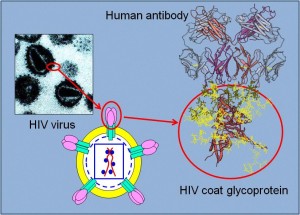
A new HIV test uses gold nanoparticles to determine the presence of the HIV biomarker p24. In the presence of the biomarker the particles clump and turn blue. Otherwise, the particles produce a red color. The test is more sensitive and a lot cheaper than other tests. From Popular Science:
To detect the AIDS-causing virus using the new method, researchers add serum from a patient’s blood sample to a solution of gold nanoparticles. If the nanoparticles come into contact with an HIV biomarker called p24, they clump together into an irregular pattern that turns the mixture blue–indicating a positive test result. If p24 is absent, the gold nanoparticles separate into ball shapes, and the mixture turns red, signaling a negative result.
Lead investigator Molly Stevens said the test could be altered to detect other diseases, including malaria, sepsis, prostate cancer, tuberculosis, and leishmaniasis
Also check out the original publication in Nature Nanotechnology.

